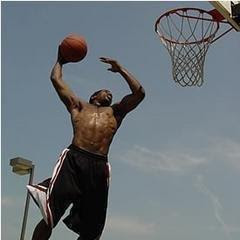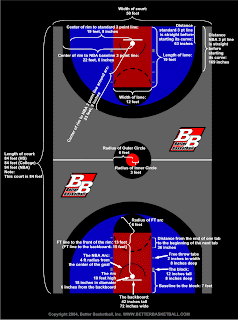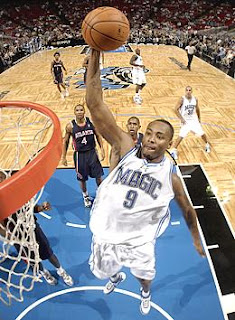WNBA
RULE: FREE THROW POSITIONS (Mandatory Spots)NCAA: Only bottom two lane spaces must be occupied by opponents of the free throw shooter. All players must be above the free throw line extended and behind the 3 pt. line NBA: Bottom four spaces (starting adjacent to baseline) must be occupied. All other players can be 6 feet from the free throw lane and/or 3 feet from the free throw circle.WNBA: NBA
RULE: OPPOSING COACH OR COACH OF INJURED PLAYER SELECTS THE SUBSTITUTE TO ATTEMPT FREE THROWS NCAA: A coach of an offended player (who cannot attempt free throw(s) can select a substitute player to attempt free throw(s)NBA: If an offended player cannot attempt free throws (due to injury), the opposing coach may select (from his opponents bench) a player to attempt free throw(s). The injured player may not return to the game.WNBA: NBA
RULE: TEN SECOND RULENCAA: N/ANBA: No more than 10 seconds of continuous control in the backcourt.WNBA: NBA
RULE: STOPPAGE OF TIMING DEVICENCAA: Last minute of regulation and/or overtime following a successful field goal attempt. No substitutions allowed. NBA: Last two minutes of regulation play and/or overtime following a successful field goal attempt.WNBA: Clock stops in last minute of each half and overtime following successful field goal attempt.
RULE: ADVANCING THE BALL AFTER A TIMEOUTNCAA: N/ANBA: After being awarded a timeout in the last 2 minutes of the game, the offensive team may select where to put the ball in play (midcourt line or designated spot out-of-bounds) if the ball has not been advanced. Ball must be passed into the front court.WNBA: After being awarded a regular or 20 second timeout in the last minute of the game or overtime, the offensive team may select where to put the ball in play (midcourt or designated spot out-of-bounds) if the ball has not been advanced. The ball must be passed into the front court.
RULE: FOULS, PENALTIES AND TECHNICALSNCAA: Technical foul (2 FT and ball) - unsportsmanlike conduct. Flagrant personal foul (2 FT and ball) - involves violent contact and ejection. Flagrant technical foul (2 FT and ball) - persistent noncontact unsportsmanlike conduct - ejection. Intentional foul (2 FT and ball) - not a legitimate attempt to play the ball or player.NBA: Flagrant foul penalty 1 (2 FT and ball) Flagrant foul penalty 2 (2 FT and ball; offender is ejected) Fighting foul (Technical foul, no FT's and offenders are ejected) Pushing foul (1 FT and ball; offender is ejected) Loose ball foul (1 FT plus penalty FT and ball) Elbow foul (offender is ejected)WNBA: NBA
RULE: SUBSTITUTIONS DURING 20-SECOND TIMEOUTSNCAA: 5 minutesNBA: Limited to 1 per team. If the team calling the timeout makes a substitution, then the opposing team can also substitute a player.WNBA: NBA
RULE: SHOT CLOCKNCAA: 30 secondsNBA: 24 secondsWNBA: NCAA
RULE: TEAM FOULS/BONUS FREE THROWNCAA: 7 team fouls (shoot 1+1)NBA: 5 team fouls per period (shoot 2) (If a team has not reached 4 team fouls in the first 10 minutes of each period, the team gets one more in the last 2 minutes without penalty) Overtime - Team fouls over 3 result in a penalty of two free throws.WNBA: 8 team fouls per half = 2 free throws. In final minute of each half, if a team has not reached 8 team fouls or 3 team fouls in overtime, it shall be permitted one more without penalty; on the second foul the team will shoot 2 free throws. Overtime - Team fouls over 3 result in a penalty of two free throws.
RULE: JUMP BALLNCAA: Only at start of game - then teams alternate possessionNBA: YesWNBA: NBA
Thursday, April 30, 2009


This article has the is a less formal variant of basketball, played on playgrounds and in gymnasiums across the world. Often only one half of the court is used, but otherwise the rules of the game are very similar to those of basketball. The number of participants in a game, or a run, may range from one defender and one person on offense (known as one on one) to two full teams of five each.
Streetball is a very popular game worldwide, and some cities in the United States have organized streetball programs, such as midnight basketball, as a way for young people to keep out of trouble and avoid problems such as juvenile crime and drugs. Many cities also host their own weekend-long streetball tournaments. Hoop-It-Up and the Houston Rockets' Blacktop Battle are two of the most popular. In recent years, streetball has seen an increase in media exposure through television shows such as ESPN's "Streetball" and "City Slam", as well as traveling exhibitions such as the and1 mixtape different types of basketball including,basketball,streetball,1vs.1vs.1 etc.While the rules of Streetball are generally the same as normal basketball, Streetball places a higher emphasis on one-on-one matchups between the offense and defender. Often the attacker will perform numerous flashy moves while attempting to drive to the basket, including crossovers, jab steps, and other fake-out tricks. Streetball often features spectacular dunks and alley oops, impressive ball handling, and trash talking.
Rules vary widely from court to court. Almost invariably a "call your own foul" rule is in effect, and a player who believes he has been fouled, simply needs to call out "Foul!" or "Ball!", and play will be stopped, with the ball awarded to the fouled player's team. A common misconception is that saying "And 1" is synonymous with calling "foul." It is not. The phrase is commonly employed as a form of trash talk. For example, when a player knows they are going to make a shot and they think they are getting fouled they will say "And 1" to let their defender know, you can't even stop me even when you foul me In reality, and as the rules that follow indicate, there is no such thing as a traditional "And 1" in Streetball.
When a player calls a foul while taking a shot, and makes that shot, the basket counts. The fouled player's team gets the ball back, hence calling "ball" when a foul occurs. This rule is designed to have players call as few fouls as possible ensuring speedier game play and shorter waiting times for next. Also, the rule helps to ensure that nobody gets hurt. As a player can not foul-out in Streetball and since the duration of the game is dictated by the score, teams will often employ the intentional foul as a last resort on defense. If defensive players had to concern themselves with fouling the offensive player hard enough so that there was no chance they could make a shot it would certainly lead to unnecessary injury and probably a couple extra fights on the court. It goes without saying, calling fouls in Streetball is disfavored. The etiquette of what rightly constitutes a foul, as well as the permissible amount of protestation against such a call, are the products of individual groups, and of the seriousness of a particular game. Another common variation to the contest is the "skunk" rule. This merely means that if a player reaches a certain point without the other player scoring, the game is over. The skunk rule is often used at the score 7 to 0.
A common feature to Streetball is the 'pick up game'. To participate in most streetball games across the world one simply goes to an outdoor court where people are playing, indicate a wish to participate, and once all the players who were at the court before you have played you will get to pick your team out of the players available and play a game. Many games play up to 7, 11, 15 or 21 points with all baskets counting as one point (sometimes shots beyond the 3 point arc count as 2 points). Players often play 'win by 2' which, as in tennis, means that the team has to win by a margin of at least 2 points. Sometimes a local "dead end" limit applies; for instance a game may be played to 7, win by 2, with a 9 point dead end, which would mean scores of 7-5, 8-6, 9-7, or 9-8, would all be final; while with scores of 7-6 or 8-7, play would continue. The most common streetball game is 3 on 3 played half court though often 5 on 5 full court can be found.
Sometimes in a half-court game, a "make it, take it" rule is followed. This means that if a team scores, they get the ball again on offense. So one team could end up never getting the ball on offense if the "winners" score on every possession. Full court basketball is not played with these rules. But in most instances, the winning team gets to choose which basketball and usually which direction (which basket) they get to use.
An unusual streetball feature is having an "MC" call the game. The MC is on the court during the game and is often very close to the players (but makes an effort to not interfere with the game) and uses a microphone to provide game commentary for the fans.
Streetball is a very popular game worldwide, and some cities in the United States have organized streetball programs, such as midnight basketball, as a way for young people to keep out of trouble and avoid problems such as juvenile crime and drugs. Many cities also host their own weekend-long streetball tournaments. Hoop-It-Up and the Houston Rockets' Blacktop Battle are two of the most popular. In recent years, streetball has seen an increase in media exposure through television shows such as ESPN's "Streetball" and "City Slam", as well as traveling exhibitions such as the and1 mixtape different types of basketball including,basketball,streetball,1vs.1vs.1 etc.While the rules of Streetball are generally the same as normal basketball, Streetball places a higher emphasis on one-on-one matchups between the offense and defender. Often the attacker will perform numerous flashy moves while attempting to drive to the basket, including crossovers, jab steps, and other fake-out tricks. Streetball often features spectacular dunks and alley oops, impressive ball handling, and trash talking.
Rules vary widely from court to court. Almost invariably a "call your own foul" rule is in effect, and a player who believes he has been fouled, simply needs to call out "Foul!" or "Ball!", and play will be stopped, with the ball awarded to the fouled player's team. A common misconception is that saying "And 1" is synonymous with calling "foul." It is not. The phrase is commonly employed as a form of trash talk. For example, when a player knows they are going to make a shot and they think they are getting fouled they will say "And 1" to let their defender know, you can't even stop me even when you foul me In reality, and as the rules that follow indicate, there is no such thing as a traditional "And 1" in Streetball.
When a player calls a foul while taking a shot, and makes that shot, the basket counts. The fouled player's team gets the ball back, hence calling "ball" when a foul occurs. This rule is designed to have players call as few fouls as possible ensuring speedier game play and shorter waiting times for next. Also, the rule helps to ensure that nobody gets hurt. As a player can not foul-out in Streetball and since the duration of the game is dictated by the score, teams will often employ the intentional foul as a last resort on defense. If defensive players had to concern themselves with fouling the offensive player hard enough so that there was no chance they could make a shot it would certainly lead to unnecessary injury and probably a couple extra fights on the court. It goes without saying, calling fouls in Streetball is disfavored. The etiquette of what rightly constitutes a foul, as well as the permissible amount of protestation against such a call, are the products of individual groups, and of the seriousness of a particular game. Another common variation to the contest is the "skunk" rule. This merely means that if a player reaches a certain point without the other player scoring, the game is over. The skunk rule is often used at the score 7 to 0.
A common feature to Streetball is the 'pick up game'. To participate in most streetball games across the world one simply goes to an outdoor court where people are playing, indicate a wish to participate, and once all the players who were at the court before you have played you will get to pick your team out of the players available and play a game. Many games play up to 7, 11, 15 or 21 points with all baskets counting as one point (sometimes shots beyond the 3 point arc count as 2 points). Players often play 'win by 2' which, as in tennis, means that the team has to win by a margin of at least 2 points. Sometimes a local "dead end" limit applies; for instance a game may be played to 7, win by 2, with a 9 point dead end, which would mean scores of 7-5, 8-6, 9-7, or 9-8, would all be final; while with scores of 7-6 or 8-7, play would continue. The most common streetball game is 3 on 3 played half court though often 5 on 5 full court can be found.
Sometimes in a half-court game, a "make it, take it" rule is followed. This means that if a team scores, they get the ball again on offense. So one team could end up never getting the ball on offense if the "winners" score on every possession. Full court basketball is not played with these rules. But in most instances, the winning team gets to choose which basketball and usually which direction (which basket) they get to use.
An unusual streetball feature is having an "MC" call the game. The MC is on the court during the game and is often very close to the players (but makes an effort to not interfere with the game) and uses a microphone to provide game commentary for the fans.
Monday, April 27, 2009
Friday, April 24, 2009
Subscribe to:
Posts (Atom)



